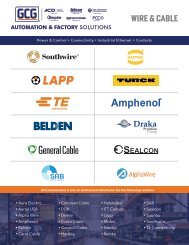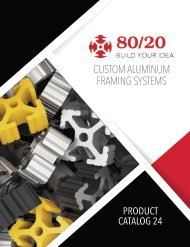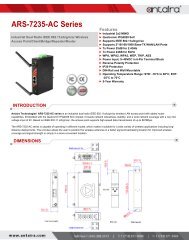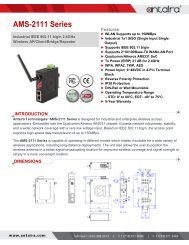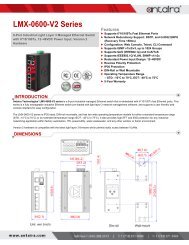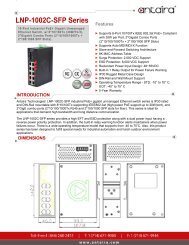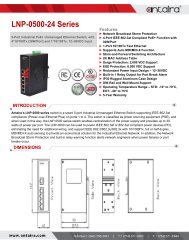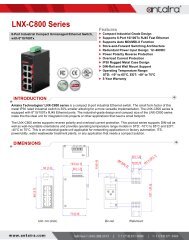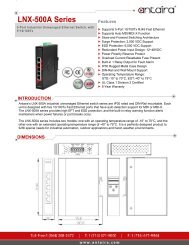- Page 1:
Enclosures and cable glands Catalog
- Page 5 and 6:
Enclosures and Cable Glands Catalog
- Page 7 and 8:
Product overview MPC Range Page C.1
- Page 9 and 10:
Contents Enclosures and Cable Gland
- Page 11 and 12:
Introduction Installation Enclosure
- Page 13 and 14:
Introduction Highest level manufact
- Page 15 and 16:
Introduction Enclosures and Cable G
- Page 17 and 18:
Contents Enclosures Klippon ® Prot
- Page 19 and 20:
Introduction Enclosures Klippon ®
- Page 21 and 22:
Control Station Large application p
- Page 23 and 24:
Klippon ® Control Station Enclosur
- Page 25 and 26:
Klippon ® Control Station Customis
- Page 27 and 28:
Klippon ® Control Station - STB -
- Page 29 and 30:
Klippon ® Control Station - STB -
- Page 31 and 32:
Klippon ® Control Station - STB -
- Page 33 and 34:
Klippon ® Control Station - STB -
- Page 35 and 36:
Klippon ® Control Station - POK -
- Page 37 and 38:
Klippon ® Control Station - POK -
- Page 39 and 40:
Klippon ® Control Station - POK -
- Page 41 and 42:
Enclosures Klippon ® Protect B 203
- Page 43 and 44:
Klippon ® Control Station - K - Al
- Page 45 and 46:
Klippon ® Control Station - K - Al
- Page 47 and 48:
Klippon ® Control Station - K - Al
- Page 49 and 50:
BEnclosures Klippon® Protect 20311
- Page 51 and 52:
Klippon ® Protect - Terminal Boxes
- Page 53 and 54:
Klippon ® Protect - Terminal Boxes
- Page 55 and 56:
Klippon ® Protect - Terminal Boxes
- Page 57 and 58:
Klippon ® Protect - Terminal Boxes
- Page 59 and 60:
Klippon ® Protect - Terminal Boxes
- Page 61 and 62:
Klippon ® Protect - Terminal Boxes
- Page 63 and 64:
Klippon ® Protect - Terminal Boxes
- Page 65 and 66:
Klippon ® Protect - Terminal Boxes
- Page 67 and 68:
Klippon ® Protect - Terminal Boxes
- Page 69 and 70:
Klippon ® Protect - Terminal Boxes
- Page 71 and 72:
Klippon ® Protect - Terminal Boxes
- Page 73 and 74:
Klippon ® Protect - Terminal Boxes
- Page 75 and 76:
Klippon ® Protect - Terminal Boxes
- Page 77 and 78:
Klippon ® Protect - Terminal Boxes
- Page 79 and 80:
Contents Enclosures Enclosures Encl
- Page 81 and 82:
Introduction Enclosures Klippon ®
- Page 83 and 84:
Introduction Enclosures C 203118000
- Page 85 and 86:
Introduction Enclosures Klippon ®
- Page 87 and 88:
Introduction Enclosures TBF Page C.
- Page 89 and 90:
Introduction Drawing design - For c
- Page 91 and 92:
Klippon ® TB enclosure series Safe
- Page 93 and 94:
Klippon ® TB MH - Multi Hinge Encl
- Page 95 and 96:
Klippon ® TB MH - Multi Hinge Klip
- Page 97 and 98:
Klippon ® TB MH - Multi Hinge Klip
- Page 99 and 100:
Klippon ® TB MH - Multi Hinge Klip
- Page 101 and 102:
Klippon ® TB MH - Multi Hinge Klip
- Page 103 and 104:
Klippon ® TB MH - Multi Hinge Klip
- Page 105 and 106:
Klippon ® TB MH - Multi Hinge Klip
- Page 107 and 108:
Klippon ® TB MH - Multi Hinge Klip
- Page 109 and 110:
Klippon ® TB MH - Multi Hinge Klip
- Page 111 and 112:
Klippon ® TB MH - Multi Hinge Klip
- Page 113 and 114:
Klippon ® TB MH - Multi Hinge Klip
- Page 115 and 116:
Klippon ® TB MH - Multi Hinge Klip
- Page 117 and 118:
Enclosures C 2031180000 C.39
- Page 119 and 120:
Klippon ® TB QL - Quarter Lock Enc
- Page 121 and 122:
Klippon ® TB QL - Quarter Lock Kli
- Page 123 and 124:
Klippon ® TB QL - Quarter Lock Kli
- Page 125 and 126:
Klippon ® TB QL - Quarter Lock Kli
- Page 127 and 128:
Klippon ® TB QL - Quarter Lock Kli
- Page 129 and 130:
Klippon ® TB QL - Quarter Lock Kli
- Page 131 and 132:
Klippon ® TB QL - Quarter Lock Kli
- Page 133 and 134:
Klippon ® TB QL - Quarter Lock Kli
- Page 135 and 136:
Klippon ® TB QL - Quarter Lock Kli
- Page 137 and 138:
Klippon ® TB QL - Quarter Lock Kli
- Page 139 and 140:
Klippon ® TB QL - Quarter Lock Kli
- Page 141 and 142:
Klippon ® TB QL - Quarter Lock Kli
- Page 143 and 144:
Enclosures C 2031180000 C.65
- Page 145 and 146:
Klippon ® TBi QL - Quarter Lock El
- Page 147 and 148:
Klippon ® TBi QL - Quarter Lock En
- Page 149 and 150:
Klippon ® TBi QL - Quarter Lock Kl
- Page 151 and 152:
Klippon ® TBi QL - Quarter Lock Kl
- Page 153 and 154:
Klippon ® TBi QL - Quarter Lock Kl
- Page 155 and 156:
Klippon ® TBi QL - Quarter Lock Kl
- Page 157 and 158:
Klippon ® TBi QL - Quarter Lock Kl
- Page 159 and 160:
Klippon ® TBi QL - Quarter Lock Kl
- Page 161 and 162:
Klippon ® TBi FS - Fixing Screw En
- Page 163 and 164:
Klippon ® TBi FS - Fixing Screw Kl
- Page 165 and 166:
Klippon ® TBi FS - Fixing Screw Kl
- Page 167 and 168:
Klippon ® TBi FS - Fixing Screw Kl
- Page 169 and 170:
Klippon ® TBi FS - Fixing Screw Kl
- Page 171 and 172:
Klippon ® TBi FS - Fixing Screw Kl
- Page 173 and 174:
Klippon ® TBi FS - Fixing Screw Kl
- Page 175 and 176:
Klippon ® STB - Sheet steel enclos
- Page 177 and 178:
Klippon ® STB - Sheet steel enclos
- Page 179 and 180:
Klippon ® STB - Sheet steel enclos
- Page 181 and 182:
Klippon ® STB - Sheet steel enclos
- Page 183 and 184:
Klippon ® STB - Sheet steel enclos
- Page 185 and 186:
Klippon ® STB - Sheet steel enclos
- Page 187 and 188:
Klippon ® K - Aluminium enclosures
- Page 189 and 190:
Klippon ® K - Aluminium enclosures
- Page 191 and 192:
Klippon ® K - Aluminium enclosures
- Page 193 and 194:
Klippon ® K - Aluminium enclosures
- Page 195 and 196:
Klippon ® K - Aluminium enclosures
- Page 197 and 198:
Klippon ® K - Aluminium enclosures
- Page 199 and 200:
Klippon ® K - Aluminium enclosures
- Page 201 and 202:
Klippon ® K - Aluminium enclosures
- Page 203 and 204:
Klippon ® K - Aluminium enclosures
- Page 205 and 206:
Klippon ® K - Aluminium enclosures
- Page 207 and 208:
Enclosures C 2031180000 C.129
- Page 209 and 210:
Klippon ® POK - Polyester enclosur
- Page 211 and 212:
Klippon ® POK - Polyester enclosur
- Page 213 and 214:
Klippon ® POK - Polyester enclosur
- Page 215 and 216:
Klippon ® POK - Polyester enclosur
- Page 217 and 218:
Klippon ® POK - Polyester enclosur
- Page 219 and 220:
Klippon ® POK - Polyester enclosur
- Page 221 and 222:
Klippon ® POK - Polyester enclosur
- Page 223 and 224:
Klippon ® POK - Polyester enclosur
- Page 225 and 226:
Klippon ® POK - Polyester enclosur
- Page 227 and 228:
Klippon ® POK - Polyester enclosur
- Page 229 and 230:
Enclosure C 2031180000 C.151
- Page 231 and 232:
TBF - Polyester enclosures Enclosur
- Page 233 and 234:
TBF - Polyester enclosures TBF 30/3
- Page 235 and 236:
TBF - Polyester enclosures TBF 60/3
- Page 237 and 238:
Enclosure C 2031180000 C.159
- Page 239 and 240:
MPC - Polycarbonate enclosures Encl
- Page 241 and 242:
MPC - Polycarbonate enclosures MPC
- Page 243 and 244:
MPC - Polycarbonate enclosures MPC
- Page 245 and 246:
Enclosures C 2031180000 C.167
- Page 247 and 248:
FPC - Polycarbonate enclosures FPC
- Page 249 and 250:
FPC - Polycarbonate enclosures FPC
- Page 251 and 252:
Contents Cable entries Cable entrie
- Page 253 and 254:
Introduction Cable entries You shou
- Page 255 and 256:
Introduction Cable entries Cable gl
- Page 257 and 258:
Standard cable glands - Plastic Cab
- Page 259 and 260:
Standard cable glands - Brass Cable
- Page 261 and 262:
Standard cable glands - Brass Cable
- Page 263 and 264:
EMC cable glands Cable glands - Bra
- Page 265 and 266:
EMC cable glands Cable glands - bra
- Page 267 and 268:
Standard cable glands - Stainless s
- Page 269 and 270:
Klippon ® Cable Glands - Introduct
- Page 271 and 272:
Klippon ® KDSW Cable Glands The KD
- Page 273 and 274:
Klippon ® KSG Cable Glands The KSG
- Page 275 and 276:
Klippon ® Cable Glands Selection G
- Page 277 and 278:
Klippon ® Cable Glands Cable entri
- Page 279 and 280:
Klippon ® Cable Glands Cable entri
- Page 281 and 282:
Cable glands for Ex applications -
- Page 283 and 284:
Cable glands for Ex applications -
- Page 285 and 286:
Cable glands for Ex applications -
- Page 287 and 288:
Cable glands for Ex applications -
- Page 289 and 290:
Cable glands for Ex applications -
- Page 291 and 292:
Cable glands for Ex applications -
- Page 293 and 294:
Cable glands for Ex applications -
- Page 295 and 296:
Cable glands for Ex applications -
- Page 297 and 298:
Cable entries D 2031180000 D.47
- Page 299 and 300:
Cable glands for Ex applications -
- Page 301 and 302:
Cable glands for Ex applications -
- Page 303 and 304:
Accessories - Lock nuts Lock nuts -
- Page 305 and 306:
Accessories - Lock nuts Lock nuts -
- Page 307 and 308:
Accessories - Flat IP washer Flat I
- Page 309 and 310:
Accessories - Flat IP washer Flat I
- Page 311 and 312:
Accessories - Earthing rings Access
- Page 313 and 314:
Accessories - Shrouds Accessories -
- Page 315 and 316:
Accessories - Washers Accessories -
- Page 317 and 318:
Blanking plugs Blanking plugs - Bra
- Page 319 and 320:
Ex - Blanking plugs Blanking plugs
- Page 321 and 322: Ex - Blanking plugs Blanking plugs
- Page 323 and 324: Adaptors Adaptors with NPT male thr
- Page 325 and 326: Compensating elements Compensation
- Page 327 and 328: Ex - Compensating elements Breather
- Page 329 and 330: Contents Cable entry system Cable e
- Page 331 and 332: Cable grommets HDC KT - Cable gromm
- Page 333 and 334: Cable entry strips and panels HDC K
- Page 335 and 336: Cable entry strips and panels HDC K
- Page 337 and 338: Strain-relief strips Strain-relief
- Page 339 and 340: Contents Tools Tools Tools Introduc
- Page 341 and 342: Introduction Tools F 2031180000 F.3
- Page 343 and 344: Hydraulic hole puncher Hydraulic sh
- Page 345 and 346: Tools F 2031180000 F.7
- Page 347 and 348: Screwdrivers Tools F 2031180000 F.9
- Page 349 and 350: SlimLine screwdriver SlimLine screw
- Page 351 and 352: Uninsulated torque screwdriver Unin
- Page 353 and 354: Cable gland tools Cable gland tools
- Page 355 and 356: VDE-insulated screwdriver VDE-insul
- Page 357 and 358: Uninsulated screwdriver Uninsulated
- Page 359 and 360: Weidmüller wrench set Weidmüller
- Page 361 and 362: Tools F 2031180000 F.23
- Page 363 and 364: Pin and electrical cabinet key Cros
- Page 365 and 366: Contents Service and support Servic
- Page 367 and 368: Service and support Professional ad
- Page 369 and 370: Service and support Product selecti
- Page 371: Contents Technical appendix Technic
- Page 375 and 376: Directive 1999/92/EC Technical appe
- Page 377 and 378: IECEx scheme IECEx scheme Technical
- Page 379 and 380: IP class of protection Definition o
- Page 381 and 382: Guidelines for selecting cable glan
- Page 383 and 384: Contents Index Index Index Index Ty
- Page 385 and 386: Type Order No. Page Type Order No.
- Page 387 and 388: Type Order No. Page Type Order No.
- Page 389 and 390: Type Order No. Page Type Order No.
- Page 391 and 392: Type Order No. Page Type Order No.
- Page 393 and 394: Order No. Type Page Order No. Type
- Page 395 and 396: Order No. Type Page Order No. Type
- Page 397 and 398: Order No. Type Page Order No. Type
- Page 399 and 400: Order No. Type Page Order No. Type
- Page 401 and 402: Order No. Type Page Order No. Type
- Page 403 and 404: Let’s connect. KR Korea Weidmulle
- Page 406: Weidmüller - Your partner in Indus



